

Mars:
Mars is the fourth planet from the Sun and the second-smallest planet in the Solar System, after Mercury. Named after the Roman god of war, it is often referred to as the "Red Planet" because the iron oxide prevalent on its surface gives it a reddish appearance. Mars is a terrestrial planet with a thin atmosphere, having surface features reminiscent both of the impact craters of the Moon and the valleys, deserts, and polar ice caps of Earth.
The rotational period and seasonal cycles of Mars are likewise similar to those of Earth, as is the tilt that produces the seasons. Mars is the site of Olympus Mons, the largest volcano and second-highest known mountain in the Solar System, and of Valles Marineris, one of the largest canyons in the Solar System. The smooth Borealis basin in the northern hemisphere covers 40% of the planet and may be a giant impact feature. Mars has two moons, Phobos and Deimos, which are small and irregularly shaped. These may be captured asteroids, similar to 5261 Eureka, a Mars trojan.
Before photography, the only recorded observations were drawings. Below, Old Mars displayed many features which were later shown not to exist.

Up till the early 1920's, we thought Mars looked like the drawings above and below. Note the ``canals'', which originally described as ``channels'' in Italian, but then was badly translated to ``canals'' which implied they were built by intelligent beings.


The dichotomy of Martian topography is striking: northern plains flattened by lava flows contrast with the southern highlands, pitted and cratered by ancient impacts. Research in 2008 has presented evidence regarding a theory proposed in 1980 postulating that, four billion years ago, the northern hemisphere of Mars was struck by an object one-tenth to two-thirds the size of Earth's Moon. If validated, this would make the northern hemisphere of Mars the site of an impact crater 10,600 by 8,500 km (6,600 by 5,300 mi) in size, or roughly the area of Europe, Asia, and Australia combined, surpassing the South Pole Aitken basin as the largest impact crater in the Solar System.
Today, Mars looks like this from the Hubble Space Telescope
Even before 1800's, it was known that Mars had some large surface features (grey-green regions between larger red regions). And it was know that Mars had seasons because the size of the polar caps changed. Mars is scarred by a number of impact craters: a total of 43,000 craters with a diameter of 5 km (3.1 mi) or greater have been found. The largest confirmed of these is the Hellas impact basin, a light albedo feature clearly visible from Earth. Due to the smaller mass of Mars, the probability of an object colliding with the planet is about half that of Earth. Mars is located closer to the asteroid belt, so it has an increased chance of being struck by materials from that source. Mars is more likely to be struck by short-period comets, i.e., those that lie within the orbit of Jupiter. In spite of this, there are far fewer craters on Mars compared with the Moon, because the atmosphere of Mars provides protection against small meteors and surface modifying processes have erased some craters. Martian craters can have a morphology that suggests the ground became wet after the meteor impacted.
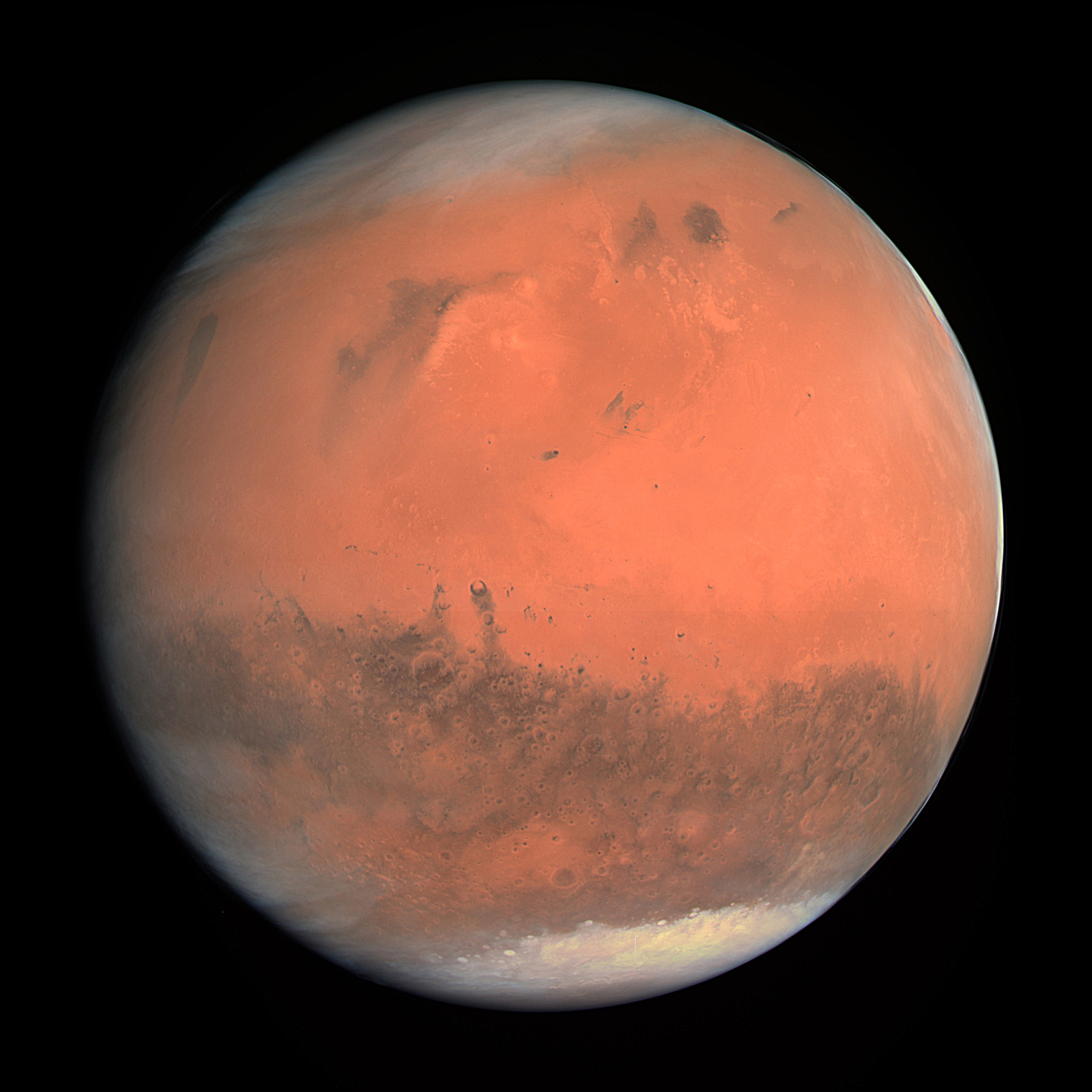
valleys and canyons
The above image is a mosaic of the Valles Marineris hemisphere of Mars. The center of the scene shows the entire Valles Marineris canyon system, more than 3,000 kilometers long and up to 8 kilometers deep. Although it appears to be a canyon formed by water, in fact, Valles Marineris is a deep crust fracture. Many huge ancient river channels begin from the chaotic terrain and north-central canyons and run north. Many of the channels flowed into a basin called Acidalia Planitia, which is the dark area in the extreme north of this picture. The three Tharsis volcanoes (dark red spots), each about 25 kilometers high, are visible to the west. Very ancient terrain covered by many impact craters lies to the south of Valles Marineris.
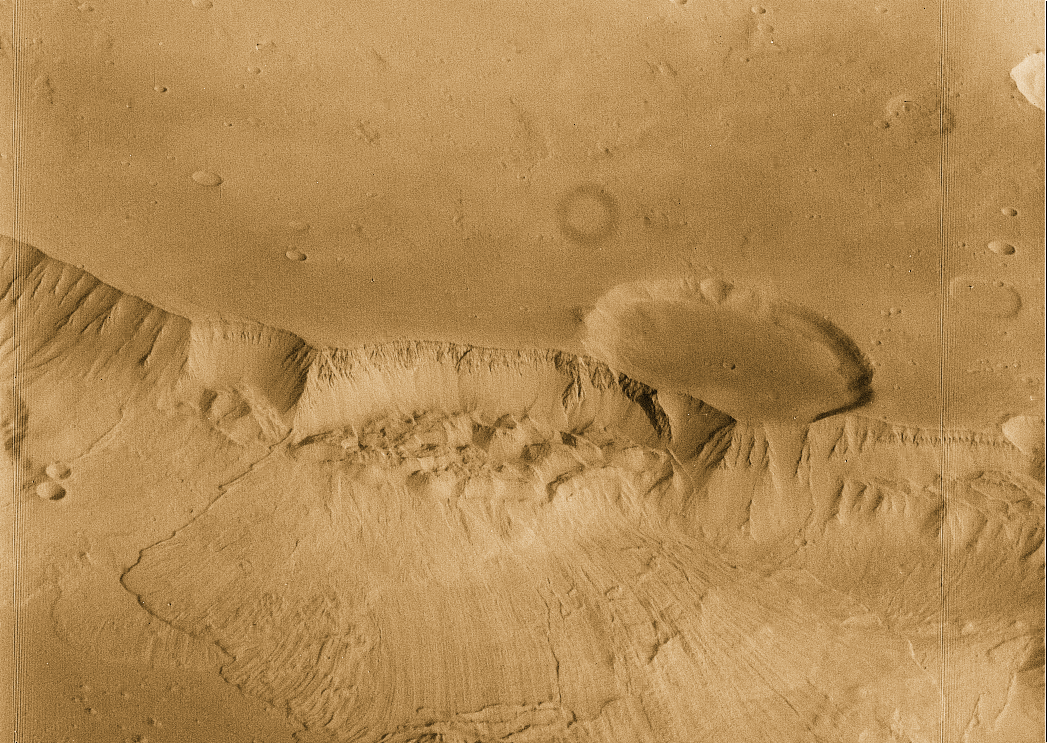
landslides
Although Valles Marineris originated as a tectonic structure, it has been modified by other processes. This image shows a close-up view of a landslide on the south wall of Valles Marineris. This landslide partially removed the rim of the crater that is on the plateau adjacent to Valles Marineris. Note the texture of the landslide deposit where it flowed across the floor of Valles Marineris. Several distinct layers can be seen in the walls of the trough.

islands
The water that carved the channels to the north and east of the Valles Marineris canyon system had tremendous erosive power. One consequence of this erosion was the formation of streamlined islands where the water encountered obstacles along its path. This image shows two streamlined islands that formed as the water was diverted by two 8-10 kilometer diameter craters lying near the mouth of Ares Vallis in Chryse Planitia. The water flowed from south to north (bottom to top of the image). The height of the scarp surrounding the upper island is about 400 meters, while the scarp surrounding the southern island is about 600 meters high.

outflows
This image of the head of Ravi Vallis shows a 300-kilometer (186-mile) long portion of a channel. Like many other channels that empty into the northern plains of Mars, Ravi Vallis originates in a region of collapsed and disrupted ("chaotic") terrain within the planet's older, cratered highlands. Structures in these channels indicate that they were carved by liquid water moving at high flow rates. The abrupt beginning of the channel, with no apparent tributaries, suggests that the water was released under great pressure from beneath a confining layer of frozen ground. As this water was released and flowed away, the overlying surface collapsed, producing the disruption and subsidence shown here. Three such regions of chaotic collapsed material are seen in this image, connected by a channel whose floor was scoured by the flowing water. The flow in this channel was from west to east (left to right). This channel ultimately links up with a system of channels that flowed northward into Chryse Basin.

polar caps
Mars has two permanent polar ice caps. During a pole's winter, it lies in continuous darkness, chilling the surface and causing the deposition of 25-30% of the atmosphere into slabs of CO2 ice (dry ice). When the poles are again exposed to sunlight, the frozen CO2 sublimes, creating enormous winds that sweep off the poles as fast as 400 km/h (250 mph). These seasonal actions transport large amounts of dust and water vapor, giving rise to Earth-like frost and large cirrus clouds. Clouds of water-ice were photographed by the Opportunity rover in 2004.
The caps at both poles consist primarily (70%) of water ice. Frozen carbon dioxide accumulates as a comparatively thin layer about one metre thick on the north cap in the northern winter only, whereas the south cap has a permanent dry ice cover about eight metres thick. This permanent dry ice cover at the south pole is peppered by flat floored, shallow, roughly circular pits, which repeat imaging shows are expanding by meters per year; this suggests that the permanent CO2 cover over the south pole water ice is degrading over time. The northern polar cap has a diameter of about 1,000 km (620 mi) during the northern Mars summer, and contains about 1.6 million cubic kilometres (380,000 cu mi) of ice, which, if spread evenly on the cap, would be 2 km (1.2 mi) thick. (This compares to a volume of 2.85 million cubic kilometres (680,000 cu mi) for the Greenland ice sheet.) The southern polar cap has a diameter of 350 km (220 mi) and a thickness of 3 km (1.9 mi). The total volume of ice in the south polar cap plus the adjacent layered deposits has been estimated at 1.6 million cubic km. Both polar caps show spiral troughs, which recent analysis of SHARAD ice penetrating radar has shown are a result of katabatic winds that spiral due to the Coriolis Effect.
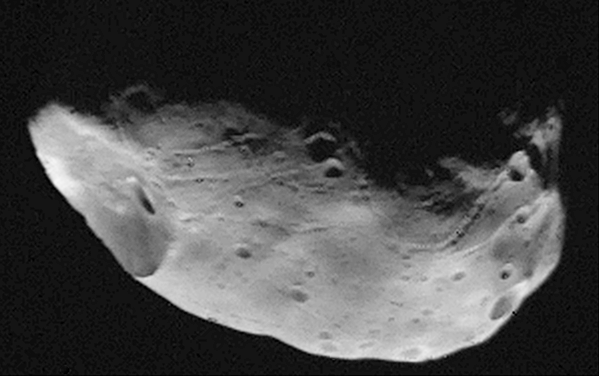
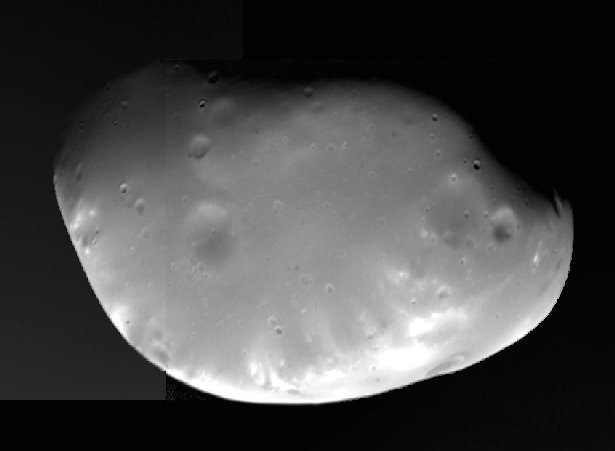
Phobos Deimos
Mars has two relatively small natural moons, Phobos (about 22 km) in diameter) and Deimos (about 12 km in diameter), which orbit close to the planet. Asteroid capture is a long-favored theory, but their origin remains uncertain. Both satellites were discovered in 1877 by Asaph Hall; they are named after the characters Phobos (panic/fear) and Deimos (terror/dread), who, in Greek mythology, accompanied their father Ares, god of war, into battle. Mars was the Roman counterpart of Ares. In modern Greek, though, the planet retains its ancient name Ares.
From the surface of Mars, the motions of Phobos and Deimos appear different from that of the Moon. Phobos rises in the west, sets in the east, and rises again in just 11 hours. Deimos, being only just outside synchronous orbit where the orbital period would match the planet's period of rotation rises as expected in the east but slowly. Despite the 30-hour orbit of Deimos, 2.7 days elapse between its rise and set for an equatorial observer, as it slowly falls behind the rotation of Mars.
Other Surface features:
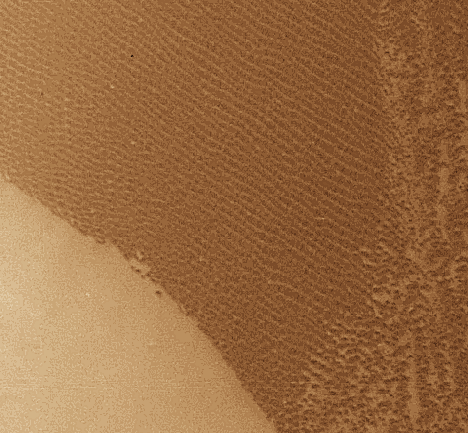

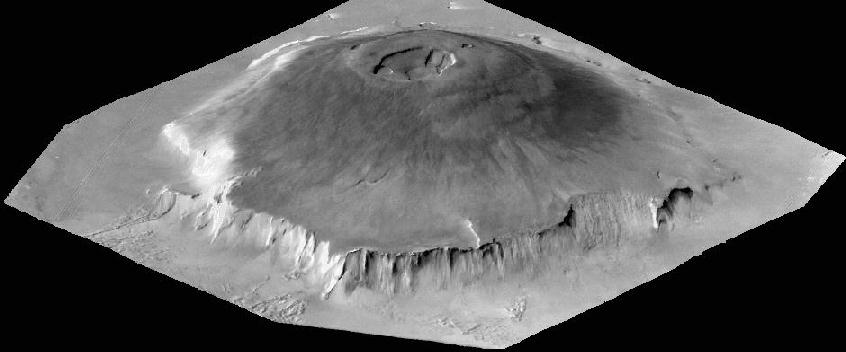
Olympus Mons
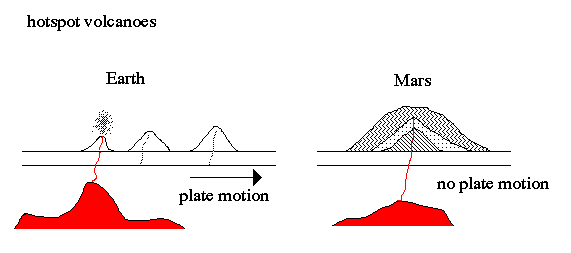

Water on Mars:
There is a great deal of evidence of the existence of liquid water on Mars, at least in the far past.
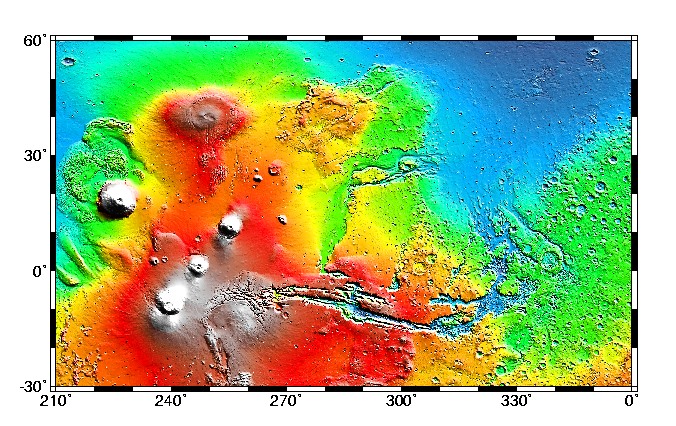
First, the secondary atmosphere for all terrestrial worlds is rich in CO2, H2O and SO2. On Earth, the temperature is just right for H2O to rain out and form oceans. On Venus, the temperature is too hot and H2O stays as a vapor to be destroyed by photodisintegration.
On Mars, it is too cold for large amounts of liquid water (i.e. oceans and lakes). Currently, all the H2O is locked up in permafrost and subsurface ice reservoirs. But notice that most of the water flow features (e.g. islands) are near the base of old volcanoes or impact craters. It implies that these features were caused by past events that heated the subsurface ice to produce a short-lived flow of liquid H2O. In addition, Mars Pathfinder found numerous pebbles rounded by water flow.
Mars did have a warmer, wetter past. Was this enough to start life?
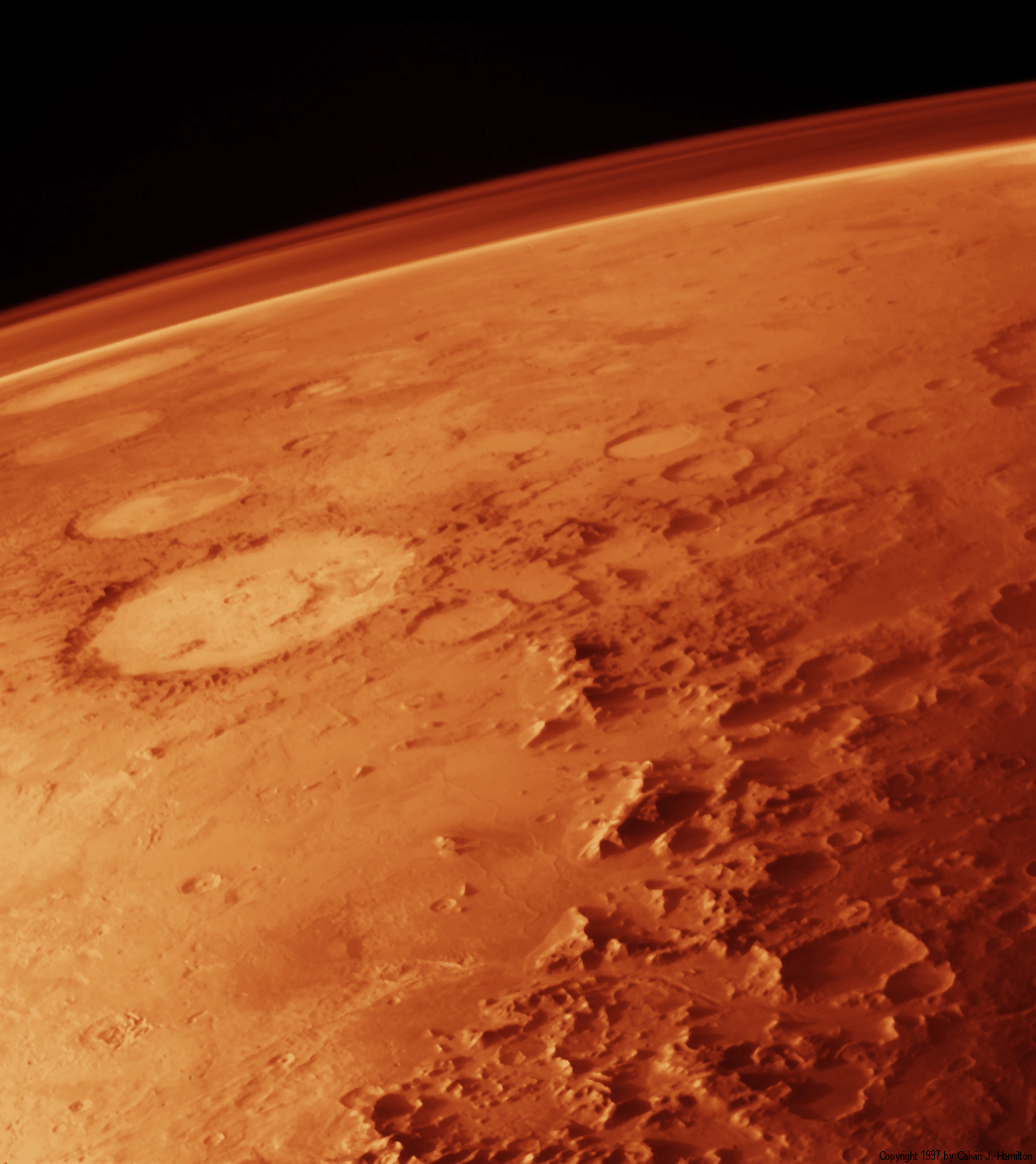
Martian Atmosphere:
Mars lost its magnetosphere 4 billion years ago, possibly because of numerous asteroid strikes, so the solar wind interacts directly with the Martian ionosphere, lowering the atmospheric density by stripping away atoms from the outer layer. Both Mars Global Surveyor and Mars Express have detected ionised atmospheric particles trailing off into space behind Mars, and this atmospheric loss is being studied by the MAVEN orbiter.
Compared to Earth, the atmosphere of Mars is quite rarefied. Atmospheric pressure on the surface today ranges from a low of 30 Pa (0.030 kPa, where 101,325 Pa to a standard atmosphere, bar) on Olympus Mons to over 1,155 Pa (1.155 kPa, about 0.01 sea level on Earth) in Hellas Planitia, with a mean pressure at the surface level of 600 Pa (0.60 kPa). The highest atmospheric density on Mars is equal to that found 35 km (22 mi) above Earth's surface. The resulting mean surface pressure is only 0.6% of that of Earth (101.3 kPa). The scale height of the atmosphere is about 10.8 km (6.7 mi), which is higher than Earth's, 6 km (3.7 mi), because the surface gravity of Mars is only about 38% of Earth's, an effect offset by both the lower temperature and 50% higher average molecular weight of the atmosphere of Mars.
The atmosphere of Mars consists of about 96% CO2, 2% N2, 2% Ar and less than 1% O2. A high noble gas content implies that Mar's atmosphere was much thicker in the past (noble gases do not react with other elements and are heavy enough to stay within the gravitational field of Mars). The atmosphere is quite dusty, containing particulates about 0.015 mm in diameter which give the Martian sky a tawny color when seen from the surface. It may take on a pink hue due to iron oxide particles suspended in it.
Mars is another example of a secondary atmosphere from outgassing (therefore, we know that Mars must have had an early epoch of tectonic activity).
The climate on Mars is desert-like due to its thin atmosphere. There is too little mass in the atmosphere to hold in heat (very little greenhouse effect). The warmest daytime temperatures are around 50 degrees F, but the nighttime temperatures plunge to -170 degrees F. Other Martian weather features are dust storms and occasional CO2 fog in the canyons.
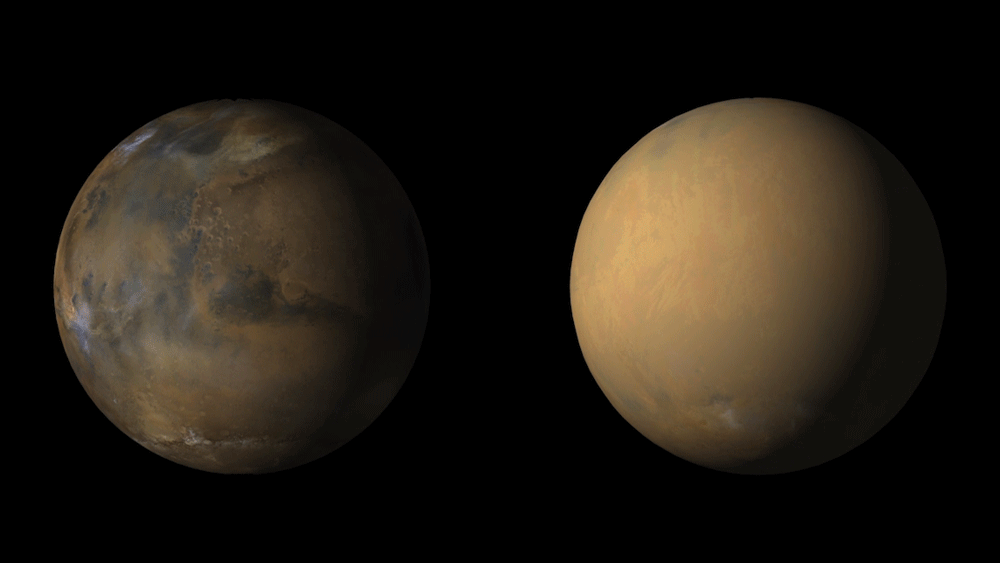
Mars has the largest dust storms in the Solar System, reaching speeds of over 160 km/h (100 mph). These can vary from a storm over a small area, to gigantic storms that cover the entire planet. They tend to occur when Mars is closest to the Sun, and have been shown to increase the global temperature.
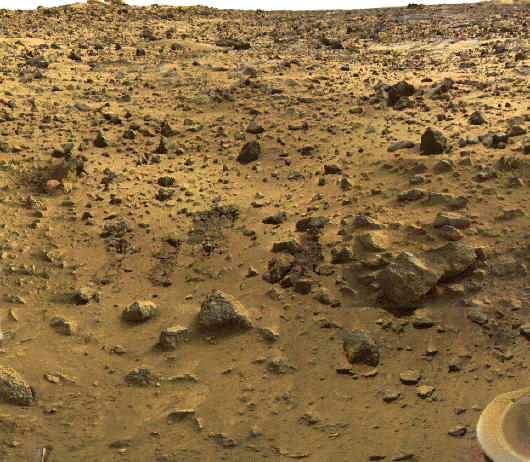

Viking Lander 1 Viking Lander 2
Martian Soil:
Our first views of the Martian surface came from the Viking Lander 1 and Viking Lander 2. They indicated a surface and soil that is mostly old impact debris with sand-blasted gravel. The soil is rich in Si and Fe, Fe oxide (rust) given Mars its red color.
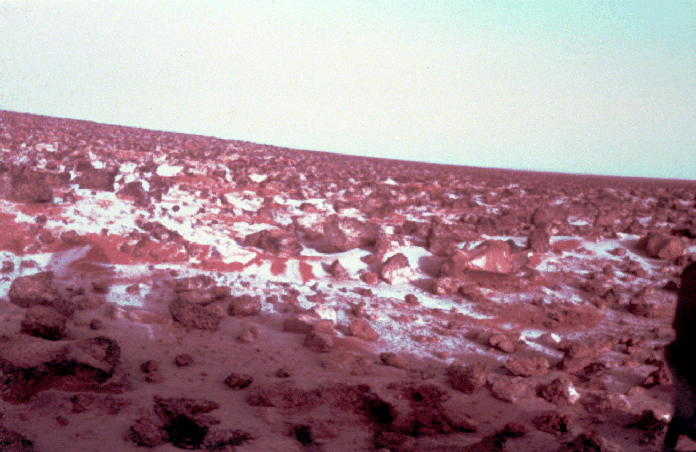
Viking also showed that Martian winter is think with frost, but that this frost was mostly CO2 ice.

In the summer of 1997, Mars Pathfinder landed on the surface of Mars. The lander contained cameras and meteorological instruments, and also carried a robot rover (shown below) whose job was to take soil and rock samples.


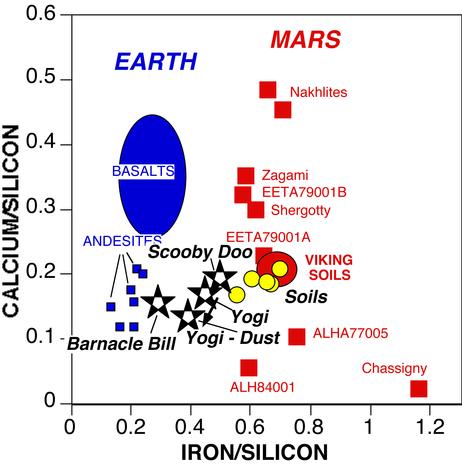
As the chart above shows, the Martian soil and rocks have a high abundance of iron and calcium, such as iron, compared to Earth rocks. Note also that the squares, Martian meteorites, proves they fell on the Earth from Mars.
The low surface gravity of Mars has produced a crust and soil that is not as chemically differentiated as the Earth's crust. Meaning that the soil of Mars is rich in heavy metals such as Fe. This was show with the magnetic results from Pathfinder.
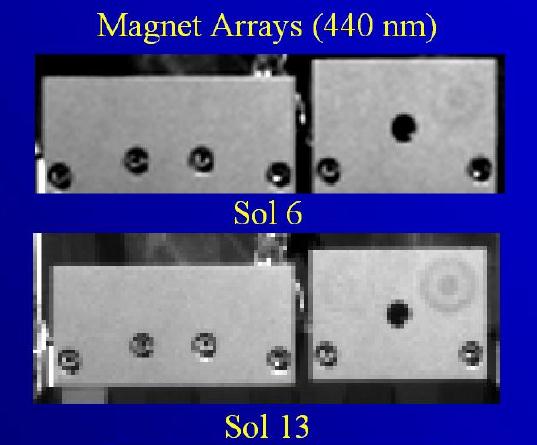
Liquid water cannot exist on the surface of Mars due to low atmospheric pressure, which is less than 1% that of Earth's, except at the lowest elevations for short periods. Landforms visible on Mars strongly suggest that liquid water has existed on the planet's surface. Huge linear swathes of scoured ground, known as outflow channels, cut across the surface in about 25 places. These are thought to be a record of erosion caused by the catastrophic release of water from subsurface aquifers, though some of these structures have been hypothesized to result from the action of glaciers or lava. Further evidence that liquid water once existed on the surface of Mars comes from the detection of specific minerals such as hematite and goethite, both of which sometimes form in the presence of water. In 2005, radar data revealed the presence of large quantities of water ice at the poles and at mid-latitudes. The Mars rover Spirit sampled chemical compounds containing water molecules in March 2007. The Phoenix lander directly sampled water ice in shallow Martian soil on July 31, 2008.
The Three Ages of Mars:
Based on what we have learned from spacecraft missions, scientists view Mars as the "in-between" planet of the inner solar system. Small rocky planets such as Mercury and Earth's Moon apparently did not have enough internal heat to power volcanoes or to drive the motion of tectonic plates, so their crusts grew cold and static relatively soon after they formed when the solar system condensed into planets about 4.6 billion years ago. Devoid of atmospheres, they are riddled with craters that are relics of impacts during a period of bombardment when the inner planets were sweeping up remnants of small rocky bodies that failed to "make it as planets" in the solar system's early times.
Earth and Venus, by contrast, are larger planets with substantial internal heat sources and significant atmospheres. Earth's surface is continually reshaped by tectonic plates sliding under and against each other and materials spouting forth from active volcanoes where plates are ripped apart. Both Earth and Venus have been paved over so recently that both lack any discernible record of cratering from the era of bombardment in the early solar system.
Mars appears to stand between those sets of worlds, on the basis of current yet evolving knowledge. Like Earth and Venus, it possesses a myriad of volcanoes, although they probably did not remain active as long as counterparts on Earth and Venus. On Earth, a single "hot spot" or plume might form a chain of middling-sized islands such as the Hawaiian Islands as a tectonic plate slowly slides over it. On Mars there are apparently no such tectonic plates, at least as far as we know today, so when volcanoes formed in place they had the time to become much more enormous than the rapidly moving volcanoes on Earth. Overall Mars appears to be neither as dead as Mercury and our Moon, nor as active as Earth and Venus. As one scientist quips, "Mars is a warm corpse if not a fire-breathing dragon." Thanks to the ongoing observations by the Global Surveyor and Odyssey orbiters, however, this view of Mars is still evolving.
Mars almost resembles two different worlds that have been glued together. From latitudes around the equator to the south are ancient highlands pockmarked with craters from the solar system's early era, yet riddled with channels that attest to the flow of water. The northern third of the planet, however, overall is sunken and much smoother at kilometer (mile) scales. There is as yet no general agreement on how the northern plains got to be that way. At one end of the spectrum is the theory that it is the floor of an ancient sea; at the other, the notion that it is merely the end product of innumerable lava flows. New theories are emerging thanks to the discoveries of Mars Odyssey, and some scientists believe a giant ice sheet may be buried under much of the relatively smooth northern plains. Many scientists suspect that some unusual internal process not yet fully understood may have caused the northern plains to sink to relatively low elevations in relation to the southern uplands.
Scientists today view Mars as having had three broad ages, each named for a geographic area that typifies it:
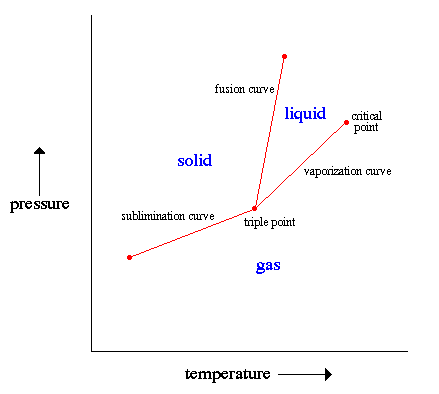



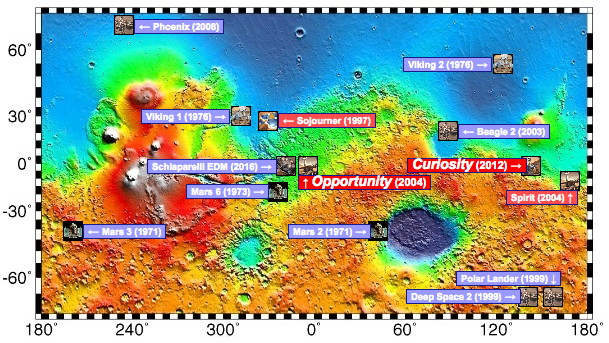
As of 2018, Mars is host to eight functioning spacecraft: six in orbit: Mars Odyssey, Mars Express, Mars Reconnaissance Orbiter, MAVEN, Mars Orbiter Mission and ExoMars Trace Gas Orbiter. In addition, there are two robots on the surface: Mars Science Laboratory Curiosity (rover) and InSight (lander).

|
|

|